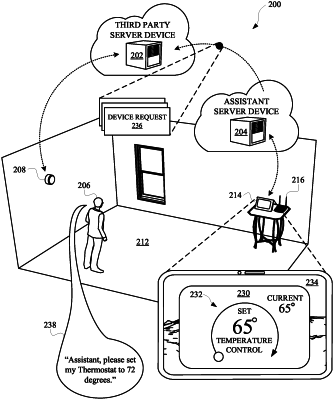| CPC H04L 12/283 (2013.01) [G10L 15/22 (2013.01); G10L 15/30 (2013.01); H04L 12/282 (2013.01); G10L 2015/223 (2013.01)] | 16 Claims |

|
1. A method implemented by one or more processors, the method comprising:
causing a client device to render content that characterizes a first status of another client device, wherein the client device and the other client device are connected to a common local area network, and the other client device is controlled using at least an automated assistant that is accessible via the client device;
determining, subsequent to causing the client device to render the content, that the client device has received a command for causing the other client device to operate according to a second status;
providing, in response to determining that the client device has received the command to cause the other client device to operate according to the second status, a request to a third party server device to cause the other client device to operate according to the second status;
receiving, subsequent to the request transmitted to the third party server device, status data from the third party server device, wherein the status data characterizes an operational status of the other client device;
when the status data indicates that the client device is operating according to the second status:
modifying, or bypassing modifying, one or more metrics, wherein the one or more metrics indicate the reliability of the third party server device to provide accurate status data, to characterize the third party server device as being reliable with respect to providing accurate status data, at least in response to the third party server device causing the other client device to exhibit any modified status relative to any previous status of the other client device;
when the status data indicates that the client device is not operating according to the second status:
modifying, or generating, the one or more metrics to indicate that the third party server device is unreliable with respect to providing the accurate status data, at least in response to the third party server device causing the other client device to exhibit any modified status relative to any previous status of the other client device.
|